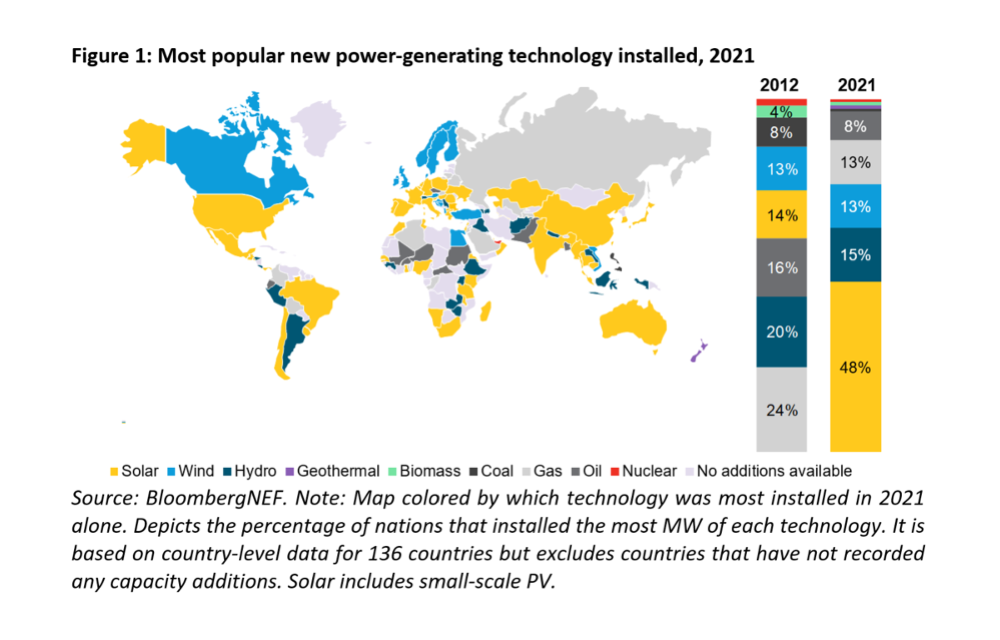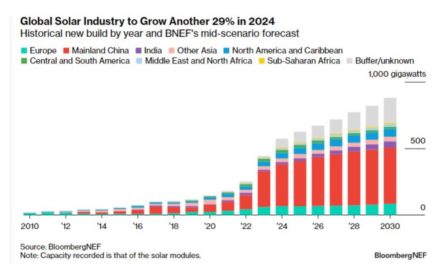- BloombergNEF’s new report says wind and solar generation together represented 10.5% of all power generation globally in 2021, the 1st time it has happened
- Global installed cumulative power generation capacity was 7.9 TW in 2021 to which solar PV contributed an annual increase of 23% with 973 GW
- Last year because of low power generation from hydro plants, natural gas becoming expensive and surge in electricity demand post COVID-19, coal generation increased leading to 7% annual increase in global carbon emissions
In 2021, wind and solar energy generation flowing into the global grid was a combined 10.5% of all power generation technologies, for the 1st time breaching the 10% mark of global electricity demand, having grown from less than 1% a decade back, according to Bloomberg New Energy Finance (BNEF).
Solar’s contribution in 2021 to the global power generation was 3.7% while wind energy accounted for 6.8%, and 39% of all power produced last year was carbon free, as per BloombergNEF’s annual Power Transition Report.
Together both wind and solar have represented the largest amount of new power generating capacity added to the grid since 2017, hitting a ‘record’ 3/4th of 364 GW built in 2021. Solar alone contributed 182 GW last year with its power generation capacity on global grids crossing 1,000 TWh for the 1st time.
In 2012, only 33 nations had solar generation of over 20 GWh concentrated in developed nations. Cut to 2021, it had spread itself to 118 countries. In 2021, 1/3rd of global solar generation was in China, followed by the US, Japan and India.
At the end of 2021, global installed solar PV capacity grew 23% to a cumulative 973 GW, while that of wind reached 833 GW. Global installed power generation capacity was 7.9 TW.
BloombergNEF’s Head of Energy Transitions Luiza Demôro said, “Renewables are now the default choice for most countries looking to add or even replace power-generating capacity. This is no longer due to mandates or subsidies, but simply because these technologies are more often the most cost-competitive.”
That goes especially for solar which has become ‘essentially ubiquitous’. According to the report, in nearly half of all countries tracked where some capacity was added, solar was the top choice in terms of volume. “At least 112 countries now have at least 1 MW of solar capacity installed,” reads the report.
Nonetheless, the world also witnessed a 5.6% annual surge in electricity demand in 2021 as the world recovered from COVID-19 pandemic which put pressure on existing infrastructure and fossil fuel supply chains. Coal fired power plants were back in business and how with an 8.5% annual record increase in generation since hydro power plants did not generate enough and natural gas prices made it unaffordable for most.
China, India and the US alone accounted for 72% of coal fired generation last year with more than 85% of it coming from 10 nations. This led to 7% increase in global carbon emissions from the power sector in 2021 on annual basis.
In fact, coal continues to be the single largest power generation source in terms of installed capacity with 27% global share, but new construction activity has come down to 13 GW in 2021, down from 31 GW in 2020 for comparison.
Of the top 10 countries that rely on coal to meet 60% of their power demand, Mongolia tops the list with over 90% of its electricity coming from this fossil fuel, followed by South Africa with 86%. The report writers add though that wind and solar use in both these nations has slowly helped reduce coal’s share.
“Renewables grew very fast, but coal’s comeback and the fact that countries – including those that have pledged to achieve net-zero emissions – continue building coal is really disconcerting,” cautioned Head of Americas at BloombergNEF, Ethan Zindler.
The complete report is available for free download on BloombergNEF’s website.















